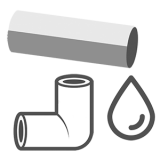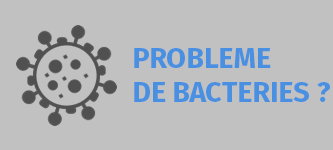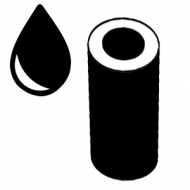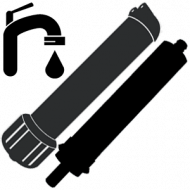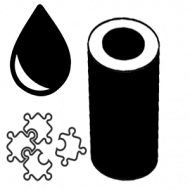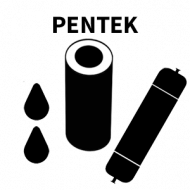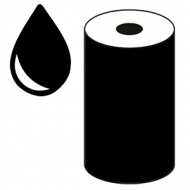| » » |
Que recherchez-vous ?
Membranes and filter cartridges: How to drink water?
Dirt filters
It is a classic filtration system without any real active ingredient, that is to say purely mechanical. Filter cartridges retain suspended particles and are suitable for reducing water turbidity. The filtration capacity is adjustable according to the size of the particles to be retained according to the filtration diameter of the cartridges. This diameter can vary from 1 to 100 μm (microns). Impurity filters are therefore suitable for multiple uses, for example retaining the sand that could be found in a recuperator as a prefilter for rainwater filtration or at the entrance to the domestic network to filter microparticles sometimes contained in the water of the network during the passage in the pipes. They may be washable or disposable, but cartridge filters need to be replaced periodically. The most resistant are the pleated filters. Their purpose is to protect the filter located downstream, generally based on activated carbon, by retaining the largest materials present in the water.
In most cases, their filtration capacity is around 5 µm for city water and 25 µm for well water. Placed at the start of the system, immediately after the meter, they limit clogging of the treatment cartridge, thus extending their lifespan and limiting their maintenance.
Polyphosphate filters
It is a filtration system that incorporates an active compound to limit or eliminate any presence of limestone.
Polyphosphate filters can be installed at the entrance to the pipe coming from the network (after the meter) or before the equipment to be protected (for example, at the entrance to a water heater).
Polyphosphates act chemically on the different components of limestone, preventing its formation. Depending on your water consumption and the capacity of the filter, you should top up the active compound once or twice a year.
Polyphosphate filters can be made in the form of filter cartridge filters.
Magnetic filters
The principle on which magnetic filters are based is substantially the same since the chemical bonds are not modified by a chemical reaction with an additive, but by the variation in the polarity of certain elements.
Like those with polyphosphates, magnetic filters make it possible to limit or eliminate incrustations or limestone. Magnetic filters have the advantage of not using consumables (nor energy for models with permanent magnets).
They are also quite small and fit easily in the kitchen.
Activated carbon filters
It is a common method of water purification that involves using an activated carbon filter. These are often easy to assemble yourself and don't cost very much either. This filter can remove organic compounds. These filters are able to remove or reduce the presence of various chemicals in the water and to some extent the turbidity and the concentration of certain heavy metals.
At the entrance to the system, they are often combined with pre-filters so that the carbons do not get dirty and reduce their life.
Generally, the brushes should be replaced at least once a year. However, it cannot filter out nitrates or bacteria. Then, it is essential to use it regularly.
The osmosis or ultra-filtration membrane cartridge
The design of the membrane filtration device is based on the main cleaning element - a synthetic boss, also called a professional membrane. The main objective is to separate the total flow of water received into purified water and that intended for washing "production waste" after direct filtration in the drainage. The liquid directed into the membrane under pressure, passing through it, is cleaned and leaves harmful impurities inside the structure. The second part of the total volume of water, after the first, "washes" the membrane and removes the "waste" left in the drain.
It is important to note that purified water, having passed through the main stage of Filtration, maintains the optimal ratio of useful elements in its chemical and mineral composition, as much as possible with careful "treatment".
- ultrafiltration (fineness of filtration from 0.2 to 0.02 microns);
- reverse osmotic (filtration fineness of 0.001 - 0.0001 micrometers);
- nanofiltration (filtration fineness from 0.01 to 0.001 µm).
In the first case, the pore size of the membrane is designed to properly rid the water of the vast majority of bacteria, salts, metals and harmful substances without allowing, due to their larger diameter, to "leak" into the flow. purified. At the same time, the construction is provided in such a way that less "useful" elements and minerals, such as calcium or magnesium, freely "pass" through the filter cartridge, thereby preserving the positive chemical composition of the water obtained as a result of the treatment process.
The construction of the reverse osmosis membrane involves the separation of the "injected" volume of water into the purest and most concentrated pollution of various kinds. This process gets its name, and was the exact opposite of the osmosis system, which in turn aims to "even out" the watertightness. The diameter of the openings in the cleaning membrane is so small that it can only "accept" the smallest water molecules. However, as in the first case described above, the particles of harmful substances still have a high chance of "shunt-cleaning", due to the smaller size relative to the diameter of the membrane pores. To eliminate this fact, manufacturers supplement the design of the unit with several additional pre-filters and a post-filter, which is responsible for the final post-treatment and mineralization of water with useful substances.
Nanofiltration membranes are only used for the post-treatment mentioned. In addition to the direct purpose - to remove the liquid from the remaining harmful elements (heavy metals, substances, impurities, microorganisms), this type of cartridge copes well with the softening of the treated liquid, depriving it of most of the available volume of salts of hardness.


